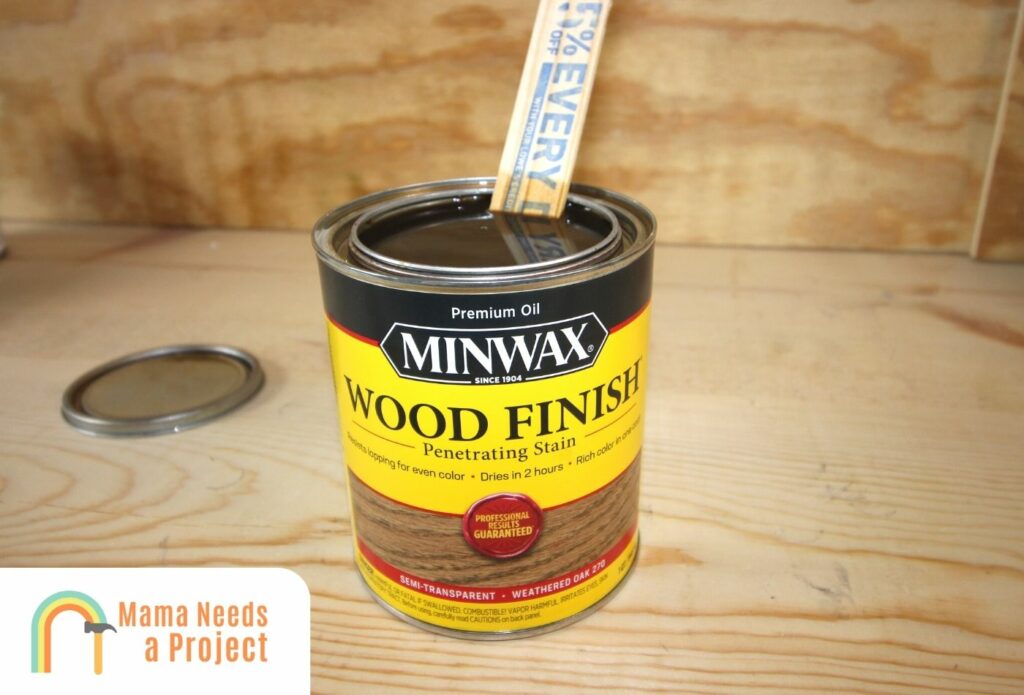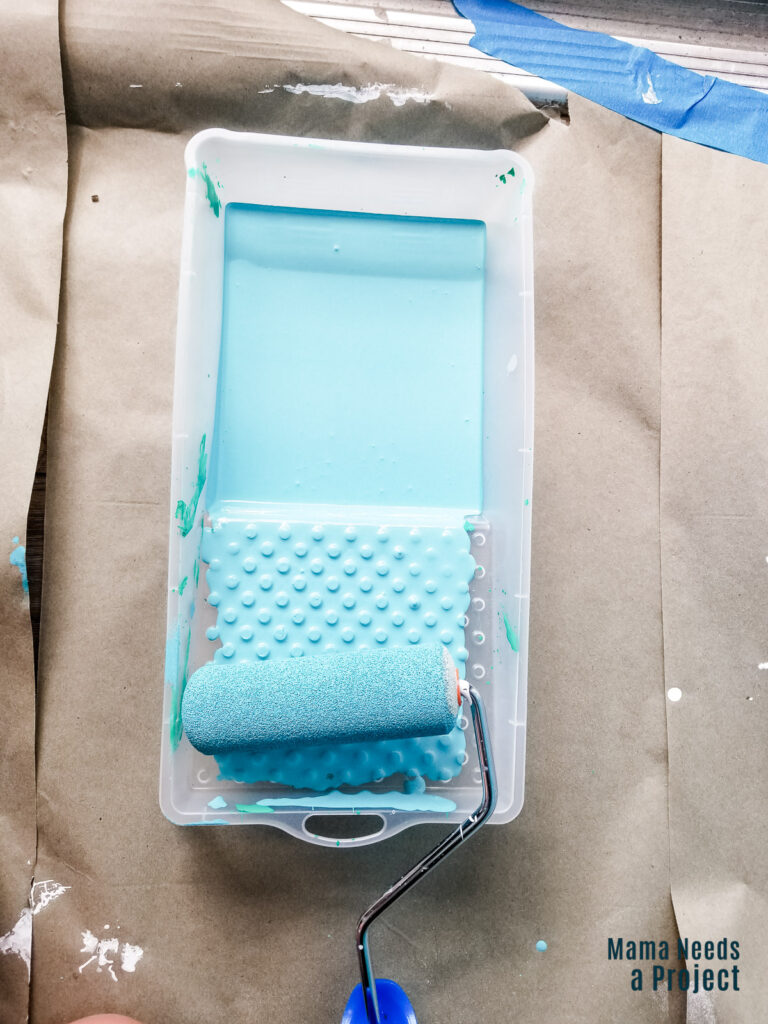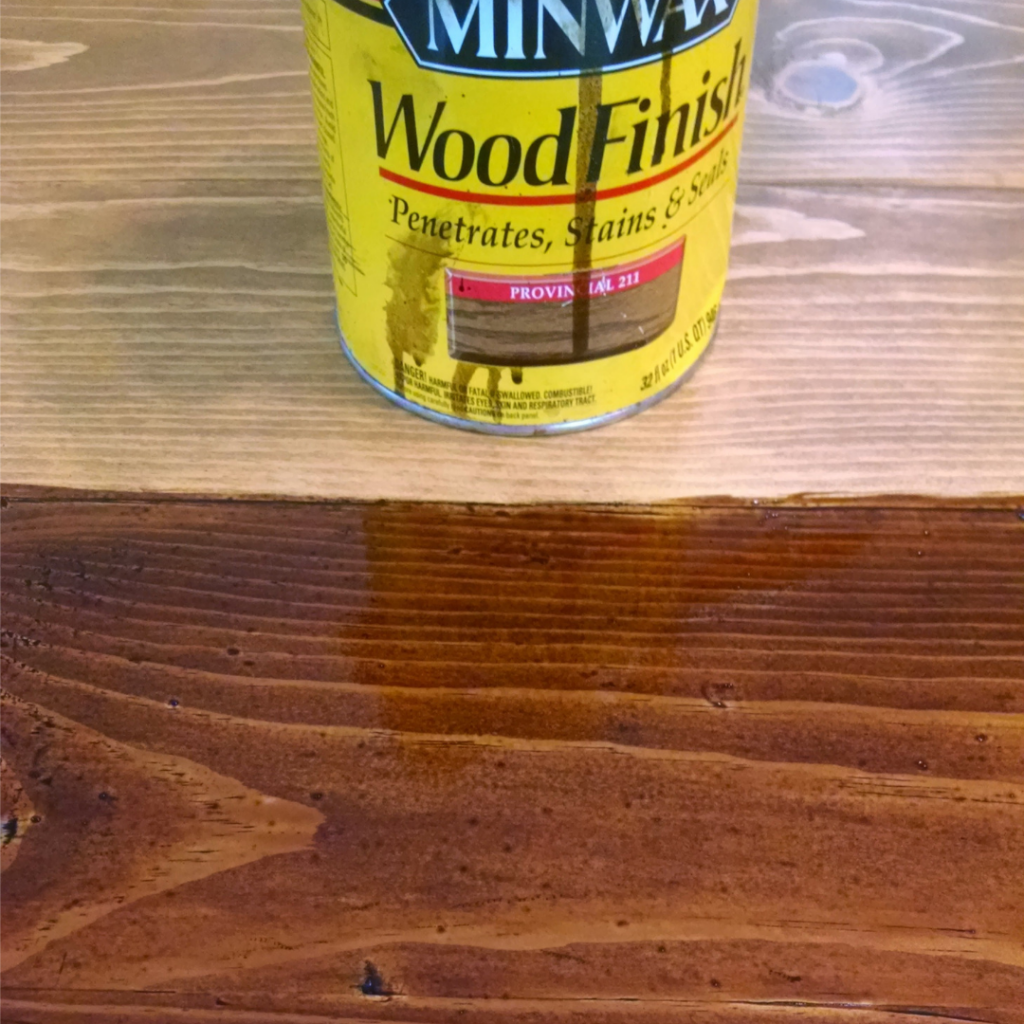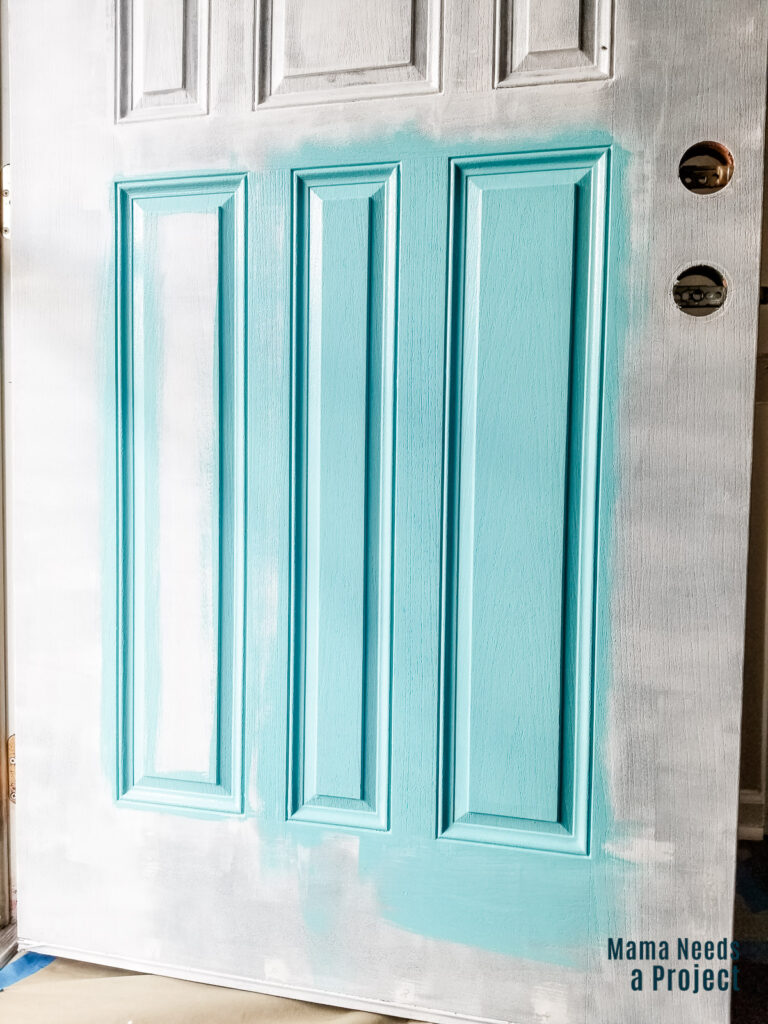Stain vs Paint: Which One Should You Pick? (Complete Guide)
I’m going to take us back to basics here, and revisit an age-old DIY woodworking question: what is the difference between stain and paint?
The great stain vs paint debate seems complex on the surface, but it’s actually pretty simple. And I’m going to show you just how simple it is!
In this post, I’ll be breaking down the major differences between wood stain and paint, and the pros and cons of using each type of colorant.
Truthfully, both materials will probably come in handy at some point. As a fellow crafter, I believe it’s never a bad idea to have stain and paint on hand! They shouldn’t break the bank, and last a while when stored properly.
And if you work with wood furniture frequently, you will definitely be using both! Let’s dig in!
- Stain is latex or oil-based, and thinner than paint. It absorbs into wood, enhancing the natural look of the wood.
- Paint is made of pigments, binders, solvents, and additives. It’s thicker than stain and sits on top of a surface, concealing wood components.
- Use stains on wooden objects to enhance their natural, organic appearance. Use paint on wooden objects that have more flaws to conceal.
Stain vs Paint: The Major Differences
Thickness
The thickness of stain vs paint is one of the main distinguishers between the two. While stains have similar components to paint, like pigments and a vehicle, stains are far thinner than paint.
Because of this, the two adhere to surfaces very differently. Due to the chemical makeup and thickness of paint, it sits on top of a surface when applied. This helps conceal any grooves, scrapes, or flaws you want to hide, and gives the object a glossier finish.
When stain is applied to a surface, it absorbs into the wood material, and the wood takes on the sheen of that stain. Since it’s thin, it won’t cover up any major kinks in the material. But it will enhance the natural beauty of the wood look.
Check out this guide to understand how much paint weighs!
Price

The price of stain vs paint is another noteworthy difference. Paint per gallon is a bit more expensive than a gallon of stain, with slight variations based on brand.
On average, you can find a gallon of quality exterior paint for anywhere from $50-$200 a can. And a gallon of quality stain can cost anywhere from $20 to $150.
You’ll also want to take into account how much paint vs stain you’ll need, depending on the given project. Painting your house’s exterior will rake up a much higher bill, as you’ll need a lot of paint.
Color & Appearance

Another major difference between paint and stain is the appearance and range of colors.
Stains have a more limited range of neutral shades, and come in natural-colored varieties. When applied, stains enhance the natural wood patterns and give off a slight sheen.
Here are the most common wood-based colors stains come in:
- Chestnut
- Ebony
- Provincial
- Kona
- Dark walnut
- Honey maple
- Red oak
- Cherry
- Puritan pine
Paints are quite different in appearance from stains. Paint comes in a wide variety of unique, eye-catching colors, and has more of a glossy or matte finish when applied to furniture or wood.
That’s why paint is often used for art pieces, unlike stain, which isn’t often used for vibrant crafts and creations, being less visually overt.
Check out my Sherwin Williams vs Valspar comparison to find out which paint is best for your projects!
Ease of Use
Are you more of a beginner painter or home project DIYer? How easy each substance is to use might be an important consideration.
When it comes to ease of use, stain definitely wins a couple brownie points! Stain is easier to apply because it’s a thinner and more absorbent colorant than paint, spreading smoother and more evenly across a given surface like a deck.
And if you need to re-coat a surface when it’s time for a touch-up, stain is also easier to apply than paint.
You also don’t need to apply two coats like you often do with paint. When painting, you’ll often need to apply more than one coat to create that desired even and glossier look.
Paint also requires you to prime a surface first, while wood stain doesn’t need a primer. So stain saves you a time-consuming step!
Longevity
The lifespan of paint vs stain on a surface sets the two apart. So what lasts longer paint or stain? Well, between paint and stain, paint surges a bit ahead on this one.
Exterior paints can last anywhere from 8-12 years before they start to flake, fade, and need a fresh repaint.
On the other hand, stains can look good for around 5 years, until your furniture or outdoor stained deck might need to be retained.
Paint also lasts much longer when stored than stain does. Properly sealed latex paints cans can stay fresh for up to 10-15 years, depending on the paint type. While properly sealed stains might only last 2-3 years.
You can also check out this video comparing paints and stains for more help!
Staining

Now you know plenty about the main differences between stain and paint. But what is wood staining all about anyway?
Wood staining, also referred to as refinishing, is the process of applying a coat of stain to a sanded wood surface to enhance its wood color and natural grain.
To refinish a wood surface, you have to first strip the wood of pre-existing stain or varnish and make sure it’s sanded. Then apply a new coat of stain and a polyurethane finish.
On the market, you’ll see transparent stains, semi transparent stain, and solid stains. The most common types of wood stains are either oil-based or latex-based. A solid color stain may work best for wooden decks and deck maintenance.
Latex-based stains are best for softwoods, and will slightly diminish the appearance of wood grain details. While oil stains are best for hardwoods and the enhancement of a wood’s natural grain details.
Now, let’s explore the pros and cons of using stain for your home improvement or woodworking project.
Staining Pros
- Has a more natural, organic appearance.
- Enhances the natural wood grain beauty.
- More resistant to chipping, flaking, and cracking than paint.
- Penetrates the wood instead of sitting on the surface, unlike paint.
- Much more budget-friendly than paint.
- Less stain required to cover a surface than paint.
- Can be applied to a surface without needing to apply a primer.
Staining Cons
- Doesn’t last as long as paint does.
- Has a shorter shelf-life than quality paint.
- May require a fresh re-coat every 3-5 years.
- Doesn’t hide flaws on wood surfaces or furniture pieces like paint can.
- Fades on a deck surface faster than paint.
- Has a limited range of color options, and isn’t as vibrant or eye-catching.
Painting

Onto painting: what is paint, and what are the big benefits and drawbacks to choosing paint over stain?
Paint is a type of coating colorant that when applied to the surface of wood can provide color, protection, and a visually appealing matte or semi gloss finish.
Paint shares similar components to stain: pigments, binders, solvents, and additives. Pigments are where the color comes from, while binders help maintain its pigment and create an adhesive film so the paint sticks to the surface.
Some paints also have additives that give it special properties, depending on the type of project you’re going for.
For example, you can purchase paints with additives that increase its durability, resistance to water (perfect for a poolside painted deck!), UV protection, and drying time.
Now, let’s go over the major pros and cons of using paint instead of stain for your home improvement project.
Painting pros
- Hides flaws and imperfections better than stain
- Comes in a wide variety of colors, mattes, glosses and sheens
- Can be applied to various materials, not just wood
- Lasts longer than stain, is more durable
- Has a longer shelf-life than solid stains
Painting cons
- Hides the natural flaws of wood
- More expensive per gallon to purchase
- Paint dries slower than stain, and takes longer to apply
- Much more labor-intensive and time consuming to to re-coat or scrape off
- Requires a paint primer before painting
- Peeling paint is very labor-intensive to scrape off
Should You Paint or Stain Wood?
First, I want to clarify that choosing stain or paint is usually a question of wood-based projects.
This is because paint can obviously be used on multiple types of surfaces. But stain was more or less made for wood (with the exception of a couple kinds being made for concrete!).
So for the purposes of this post, we’re only really discussing wood stain and wood painting.
Let’s explore the types of projects where painting might be your best option, and the projects where you might want to opt for stain instead. Spoiler: it will mostly come down to your personal preferences, in the end!
Looking to stain wood? Check out my Ready Seal vs Cabot comparison to find out which is best for your project!
Best Projects for Painting Wood
When it comes to the best projects for painting wood, the sky’s the limit! Paint comes in a wide variety of colors and sheens, making it perfect for any aesthetic, or art projects where you want to achieve a very specific look and design.
First and foremost, paint generally is superior to stain when it comes to finishing your home’s exterior. While stain may come out quite nice, it really only makes sense if you want to enhance a natural, wood-like appearance on your house (think cabin vibes!).
Paint will last far longer than stain on a house facade. And trust me when I tell you, you and your wallet might not enjoy re-staining your entire house every few years.
Ideal wood painting projects:
- House exteriors
- Wooden fences
- Interior or front doors (learn how to paint your front door without removing it!)
- Painted wooden utensils or jewelry
- Stenciled wooden accent table or nightstand
- Reclaimed wood-turned-art pieces
- Wood furniture made of multiple types of wood in one
- Any wood furniture with major flaws you can’t sand out and want to conceal
- Intricately carved or ornate furniture
- Anything you want to minimize upkeep on, as paint lasts longer
- Particle board-based items (still a bit tough to paint, but paint takes better than stain with these ones. Opt for an oil-based enamel paint)
Here’s a wood-painting tip to remember: paint works far better than stains on furniture pieces made of a variety of woods, like oak and maple. That’s because stain absorbs slightly differently into each wood grain, creating a new shade on the other components.
Also, opt for paint on any piece of furniture that has lots of cutouts, rivets, or intricate carvings. It’s much more difficult to be prepped properly and apply stain to pieces like this.
Check out this guide to understand if you can use exterior paint inside!
Best Projects for Staining Wood
Now, let’s sing stain’s praises! Are you wondering, why use stain instead of paint? Well, there actually are a variety of wood projects perfect for staining.
Staining is a budget-friendly option, so if you’re refinishing something with a wide surface area like a deck, you might save some money.
Short on time or experience? Stain is a good option. You won’t spend days painting layer over layer just to achieve uniformity.
The best projects for staining wood are going to be anything with a beautiful wooden, organic aesthetic you want to enhance rather than hide.
Ideal wood staining:
- Outdoor decks and fences
- Outdoor furniture, i.e. exterior wood tables
- Home exteriors with a natural look, i.e. cabins, chalets, wood-beamed lake houses (remember, there will be more frequent maintenance than paint!)
- Wood frames
- Any wood furniture that only has mild flaws you can easily sand out
- Wood doors
- Wood-based crafts or anything you want to look natural and rusticOutdoor furniture in particular looks great with stain! Use water-based or acrylic stains for outdoor furniture.
Need help picking a stain? Here’s our list of the best stains for outdoor furniture. Once you have your supplies, you’ll be ready to kick off your wood staining project–you got this!
Pro tip: If you’re re-staining a surface that was originally stained with oil, you’ll want to opt for an oil-based stain instead of a latex stain. Latex stains won’t adhere properly to a previously oil-stained surface.
FAQS
Is it Better to Paint or Stain a Deck?
Both work, but your choice will depend on preferences. Stain creates a wood-enhanced natural look, and is easier to apply to a deck. But it doesn’t last as long as paint against the elements, and will need to be re-stained every few years. You can use my deck stain calculator to determine how much stain you’ll need!
Is it better to paint or stain furniture?
It depends on what you’re most concerned about: price range, upkeep, or visuals. If you don’t care about upkeep and want to enhance the natural beauty of bare wood, choose stain. If you want to avoid having to re-finish as often, or you have a vibrant color or pattern in mind, paint is a good choice.
What lasts longer paint or stain?
In general, paint lasts longer than stain. Exterior wood stain will last 2-3 years until it starts to fade and may need a fresh coat. Exterior paint on decks or homes can last upwards of 10-15 years until severe peeling and cracking occurs.
Final Thoughts
I hope at this point, you feel confident in all the major differences and nuances between stain vs paint.
Luckily, you can’t go totally wrong by choosing one over the other for your woodworking project.
To reiterate, the main differences between paint and stain have to do with how long each lasts, their color options, price, ease of use, and thickness.
Stain is an economical choice for projects with big surface areas, like decks and fences. Paint, on the other hand, is great for home exteriors or furniture pieces you want to add pops of color or stenciled patterns to.
Whether you choose stain or paint, you’re about to transform your wooden surface into a beautiful work of art!

Jessica Vaillancourt is a freelance writer and blogger obsessed with the Travel, Wellness, and Personal Development industries.
She has 5+ years of experience helping human-first agencies, global companies, and entrepreneurs crush their content marketing goals, and serve more people. Jessica’s work has appeared on leading websites like UpgradedHome.com, BetterHelp.com, and TheDiaryofaNomad.com.
Today, her sole focus (besides finding the world’s best coffee shop) is writing to serve humans, and slow traveling abroad to expand her mind. You can get to know her work at JessAnneWriting.com.

